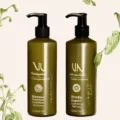Understanding Low Porosity Curly Hair
If you have curly hair, you’ve probably heard the term “porosity” thrown around in hair care discussions. But what does it really mean, especially when it comes to low porosity curly hair? Let’s dive into this fascinating aspect of hair care with compassion and a focus on embracing your natural beauty.
Low porosity hair is characterized by a tightly bound cuticle layer, which makes it difficult for moisture to penetrate the hair shaft. This doesn’t mean your hair is “bad” or “problematic” – it’s simply a unique characteristic that requires a tailored approach to care. Understanding your hair’s porosity can be a game-changer in your curly hair journey, helping you to love and nurture your locks in the best way possible.
Signs You Might Have Low Porosity Curly Hair
Recognizing whether you have low porosity hair is the first step towards giving your curls the care they deserve. Here are some signs that might indicate you have low porosity curly hair:
- Your hair takes a long time to get fully wet in the shower
- Products tend to sit on top of your hair rather than being absorbed
- Your hair is prone to product buildup
- It takes a long time for your hair to air dry
- Your hair is resistant to chemical treatments like hair dye
Remember, these characteristics aren’t flaws – they’re simply part of what makes your hair unique. Embracing these traits is key to developing a hair care routine that works for you.
Caring for Low Porosity Curly Hair with Love
Now that we understand what low porosity curly hair is, let’s explore how to care for it with love and patience. The key is to focus on moisture and gentle treatments that work with your hair’s natural structure, not against it.
- Use heat to your advantage: Low porosity hair benefits from warm treatments. Try using a heated cap or sitting under a hooded dryer when deep conditioning to help products penetrate the hair shaft.
- Choose lightweight, water-based products: Heavy oils and butters can be too much for low porosity hair. Opt for lighter, water-based products that won’t weigh your curls down.
- Clarify regularly: Because low porosity hair is prone to buildup, regular clarifying (about once a month) can help keep your scalp and hair fresh and receptive to moisture.
- Embrace the “LOC” or “LCO” method: This involves applying products in a specific order – Liquid, Oil, Cream (LOC) or Liquid, Cream, Oil (LCO) – to maximize moisture retention.
- Be patient with deep conditioning: Your hair may need more time to absorb treatments. Don’t rush the process – give your hair the time it needs to soak up all the goodness.
The Importance of Self-Love in Your Hair Journey
As you navigate the world of low porosity curly hair care, it’s crucial to remember that this journey is about more than just hair – it’s about self-love and acceptance. Your curls are a beautiful part of who you are, and caring for them should be an act of self-care and celebration.
Don’t get discouraged if you don’t see immediate results or if your hair doesn’t behave exactly like someone else’s. Every head of curls is unique, and finding what works for you is part of the adventure. Be patient with yourself and your hair, and enjoy the process of discovery.
Nourishing Products for Low Porosity Curly Hair
While everyone’s hair is different, there are some products that tend to work well for low porosity curly hair. Look for:
- Aloe vera-based products for hydration
- Lightweight leave-in conditioners
- Protein-free or low-protein products (as low porosity hair can be sensitive to protein overload)
- Humectants like glycerin or honey to attract moisture
- Lightweight oils like argan or jojoba oil for sealing in moisture
Remember, what works for one person may not work for another. It’s all about experimentation and finding what makes your curls happy and healthy.
FAQ: Your Low Porosity Curly Hair Questions Answered
Q1: Can low porosity hair change over time?
A: While your hair’s porosity is largely determined by genetics, it can be influenced by factors like heat styling, chemical treatments, and environmental exposure. However, significant changes in porosity are rare.
Q2: How often should I wash low porosity curly hair?
A: This varies from person to person, but many with low porosity curly hair find that washing 1-2 times a week works well. Listen to your hair and scalp – they’ll tell you what they need.
Q3: Is it necessary to use heat when deep conditioning low porosity hair?
A: While not absolutely necessary, heat can help open the cuticle and allow moisture to penetrate more effectively. If you prefer not to use heat, try leaving your deep conditioner on for a longer period.
Q4: Can I use protein treatments on low porosity hair?
A: Yes, but sparingly. Low porosity hair typically doesn’t need as much protein. Start with protein-free products and introduce protein treatments slowly if needed.
Q5: How can I tell if my low porosity hair is over-moisturized?
A: Signs of over-moisturized hair include excessive softness, inability to hold a curl, and a gummy or mushy texture when wet. If you notice these signs, reduce your use of moisturizing products and consider a light protein treatment.
Embracing Your Low Porosity Curls
Your low porosity curly hair is a beautiful, unique part of you. As you learn to care for it, remember that this journey is about more than just achieving perfect curls – it’s about embracing your natural beauty and treating yourself with kindness and patience.
Every curl pattern, every porosity type, every hair texture is a masterpiece in its own right. Your low porosity curls may require a bit more understanding and specialized care, but they are absolutely worth the effort. As you discover what works best for your hair, you’re not just improving your hair health – you’re practicing self-love and self-acceptance.
So, here’s to your beautiful low porosity curls! May your journey be filled with wonderful discoveries, lots of good hair days, and most importantly, a deepening appreciation for the unique and gorgeous person you are, inside and out.









